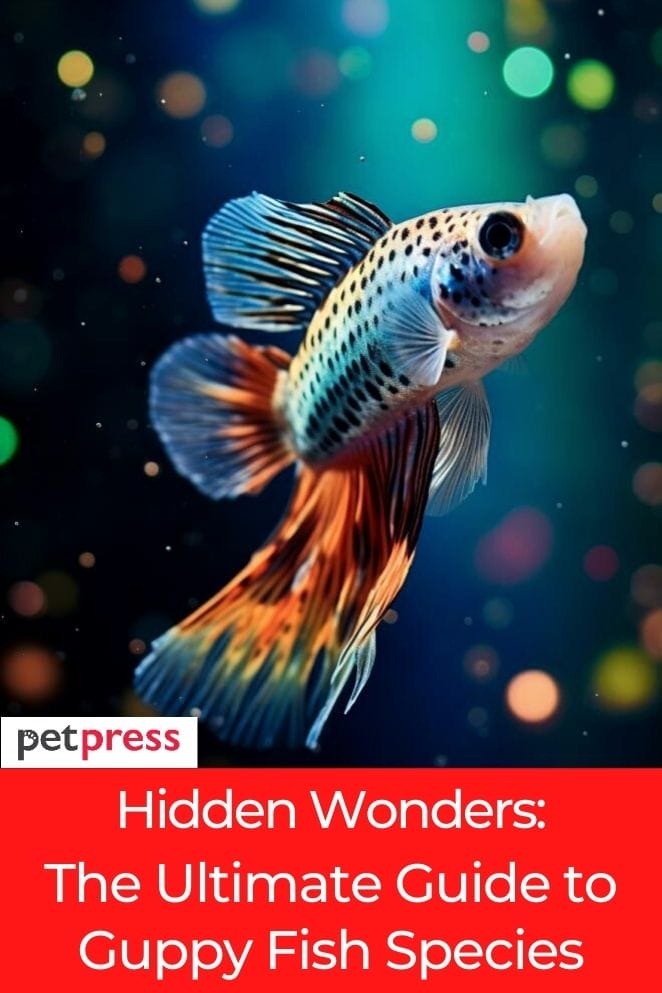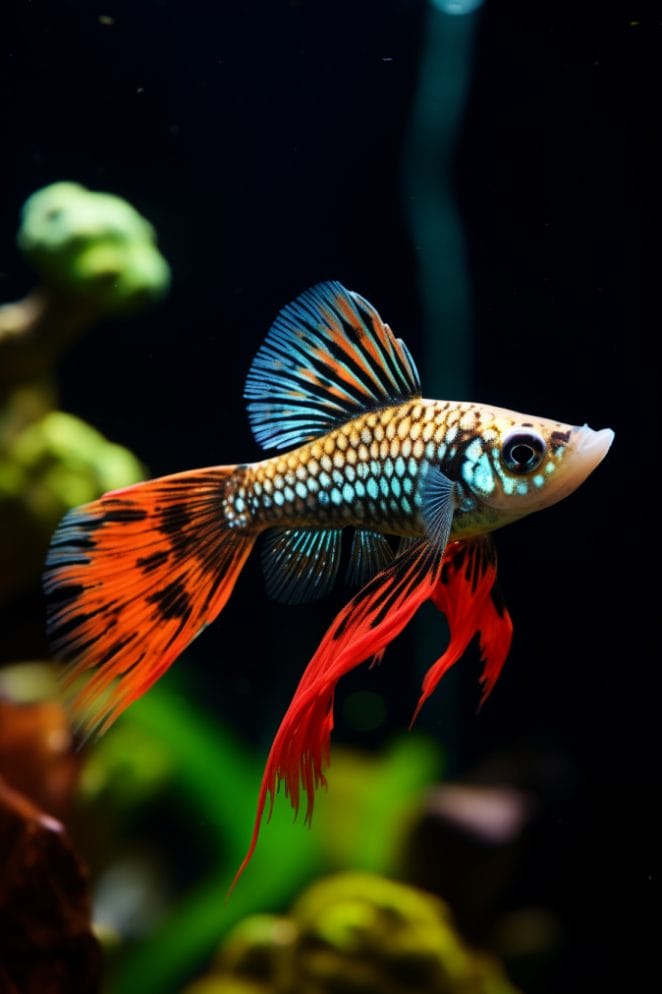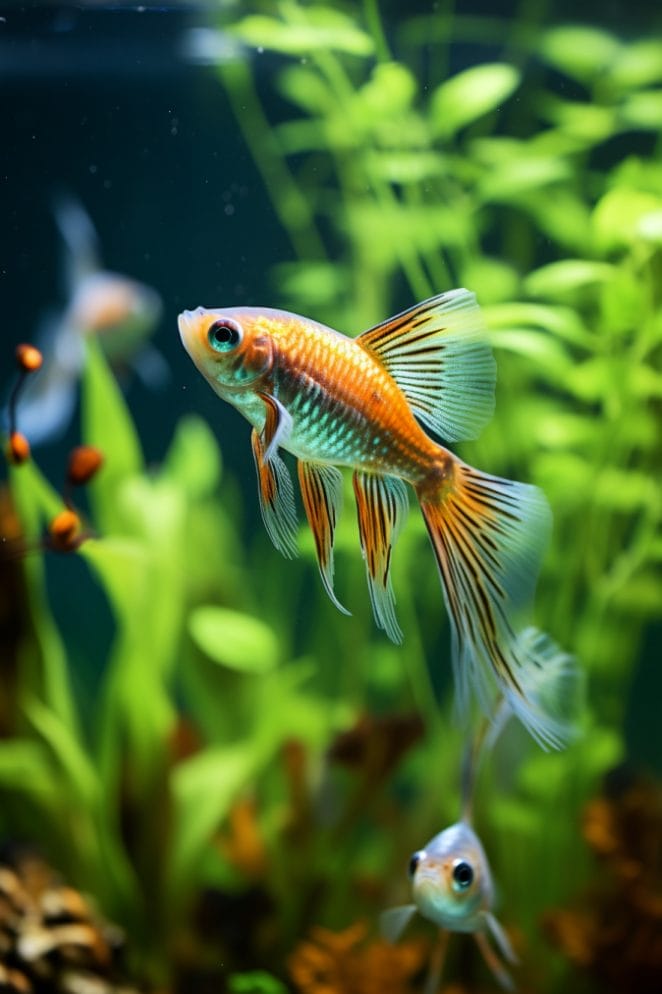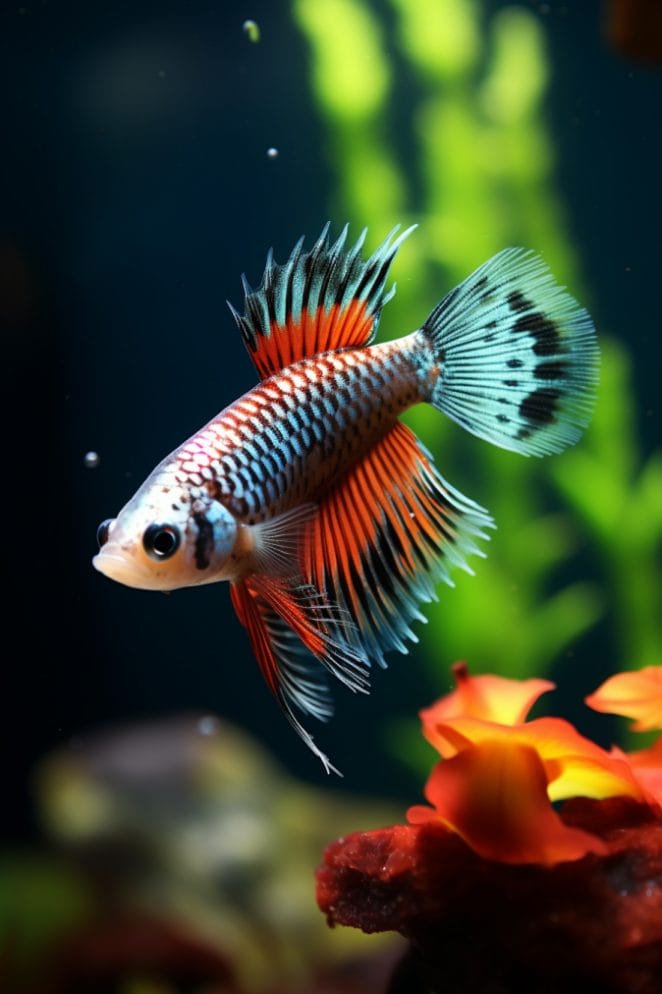
Guppies are one of the most popular and recognizable aquarium fish species.
Their vibrant colors, playful nature, and ease of care make them a favorite among both beginner and experienced fish keepers.
In this article, we will delve into the world of guppy fish, covering their characteristics, origin, colors and markings, ideal tankmates, care, diet and feeding, gender differences, breeding, and more.
Whether you’re a seasoned aquarist or a newcomer to the hobby, this guide will provide you with valuable insights into the fascinating world of guppies.
Characteristics
Guppies exhibit distinct characteristics that contribute to their unique and visually appealing appearance.
These freshwater fish are notable for their vibrant colors, adorned with long, flowing fins, and distinctive patterns.
The color spectrum of guppies spans a wide range, encompassing hues such as red, blue, green, orange, and yellow.
It’s noteworthy that their coloration is subject to variation influenced by factors like age, gender, and breeding conditions.
- Read also: 12 Popular Small Aquarium Fish Species
- Read also: 10 Best Fish For Small Tanks
Origin
Guppies originate from the tropical waters of South America, with their native habitat extending to regions like Venezuela, Guyana, and Trinidad.
In their natural environment, guppies thrive in warm, slow-moving streams and rivers.
These waters are characterized by dense vegetation, creating an ideal habitat for guppies.
The abundant vegetation serves multiple purposes, offering ample hiding spots for the fish and ensuring a constant supply of food.
This native setting provides valuable insights into the preferred conditions for guppies when replicating their environment in aquariums.

Colors and Markings
The captivating colors and markings of guppies result from years of deliberate and selective breeding.
This breeding process has led to a diverse spectrum of visual characteristics among these freshwater fish.
Guppies showcase a remarkable variety, ranging from intricate patterns to solid and intense hues.
The diversity extends to their tails and fins, which can be embellished with spots, stripes, or even metallic accents.
These distinctive features contribute to the overall visual appeal of guppies, making them a favorite among aquarium enthusiasts.
The artistry of selective breeding has not only enhanced the aesthetic qualities of these fish but also provided a fascinating glimpse into the possibilities that can be achieved through careful cultivation.
Tankmates
Guppies are known for their amiable and sociable nature, making them well-suited for cohabitation with their own kind and other non-aggressive species.
In a community tank setting, compatible tankmates for guppies include species like neon tetras, mollies, and corydoras catfish.
These fish share a peaceful disposition, creating a harmonious environment.
However, caution is advised when selecting tankmates, as guppies are susceptible to stress from fin-nipping or aggressive behavior.
It is crucial to avoid housing them with species known for such tendencies.
By choosing suitable companions, aquarium enthusiasts can foster a tranquil and thriving community where guppies can flourish alongside their tankmates.
Care
Guppies are an ideal choice for beginners due to their relatively straightforward care requirements.
Ensuring their well-being involves providing a well-filtered aquarium with ample plants and hiding spots, mimicking their natural habitat.
Maintaining a water temperature within the range of 74-82°F (23-28°C) and a pH level between 7.0 and 7.2 is crucial for their health and comfort.
Regular water changes play a vital role in keeping their environment pristine, contributing to the overall well-being of the guppies.
Additionally, a balanced diet is essential, with a variety of high-quality fish foods to meet their nutritional needs.
By adhering to these care guidelines, even novice aquarium enthusiasts can create a thriving and vibrant environment for their guppies.

Diet and Feeding
Guppies are omnivores and should be fed a varied diet consisting of high-quality flake food, freeze-dried bloodworms, brine shrimp, and vegetable matter.
It’s essential to provide them with small, frequent meals to accommodate their fast metabolism and ensure they receive adequate nutrition.
Gender Differences
Distinguishing between male and female guppies is a straightforward process.
Males exhibit a more vibrant coloration, boast a distinct gonopodium (a modified anal fin utilized for mating), and showcase a slender body.
On the other hand, females are larger in size, display less intense colors, and feature a gravid spot near their anal fin, serving as an indicator of their reproductive status.
These clear gender differences make it easy for aquarium enthusiasts to identify and appreciate the unique characteristics of male and female guppies within their aquatic community.
Understanding these distinctions is valuable for those interested in breeding or simply observing the behaviors of these colorful and engaging freshwater fish.
Breeding
Guppies are known for their prolific breeding habits, captivating the interest of aquarium enthusiasts.
One intriguing aspect is the ability of female guppies to store sperm for several months, enabling them to produce multiple broods of fry without the need for additional mating.
To manage the potential challenge of overpopulation, it is recommended to either separate male and female guppies or create an environment with ample hiding places for the fry.
This approach helps control the breeding process, allowing aquarists to maintain a balanced and manageable population within their aquarium.
Understanding and managing the unique breeding characteristics of guppies contribute to a fulfilling and rewarding experience for those caring for these fascinating freshwater fish.
How many species of guppies are there?
Guppies, classified under the Poeciliidae family, are represented by the recognized species Poecilia reticulata.
While there is one acknowledged species in their natural habitat, the aquarium trade has introduced a myriad of guppy variations.
These variations, a result of selective breeding, encompass an extensive array of color variations and tail types, adding to the diversity and appeal of guppies available to enthusiasts.
In essence, while there is one species in the wild, the world of aquariums has given rise to a broad spectrum of captivating guppy traits and characteristics.

What is the prettiest type of guppy?
Determining the “prettiest” type of guppy is a subjective matter, as beauty lies in the eye of the beholder.
Various guppy enthusiasts may have distinct preferences – some might be drawn to the vibrant colors and intricate patterns exhibited by mosaic guppies, while others may find the elegance of tuxedo guppies particularly captivating.
In essence, the perception of the “prettiest” guppy is deeply personal and varies from one individual to another.
The diverse array of guppy types available in the aquarium trade ensures that there is a guppy to suit every taste and preference, making the world of guppy appreciation as diverse as the fish themselves.
- Read also: What Do Betta Fish Eat: A Beginners Guide
- Read also: 5 Popular Large Freshwater Aquarium Fish
Conclusion
Guppies truly stand out in the aquatic world with their captivating presence.
Their vibrant colors, lively behavior, and easy care make them a perfect choice for aquarists of any expertise level.
To ensure the best for these charming fish, it’s crucial to grasp their distinctive traits, origins, suitable tankmates, and necessary care practices.
By doing so, you can create a flourishing environment where the unique beauty of guppies truly comes to life.
FAQs
While guppies are hardy fish, they thrive best in a well-filtered aquarium. A filter helps maintain water quality and provides aeration, essential for the health of the fish.
On average, guppies have a lifespan of 1-3 years, although with proper care, some individuals may live longer.
Guppies are not true schooling fish but are social and enjoy the company of their kind. Keeping them in groups of 4 or more is recommended to prevent stress and encourage natural behavior.
Guppies and goldfish have different dietary requirements. It’s best to feed them species-specific food to ensure they receive the nutrients they need for optimal health.
Guppies are peaceful fish and are not aggressive. However, male guppies may exhibit territorial behavior, especially in the presence of other males.


GIPHY App Key not set. Please check settings